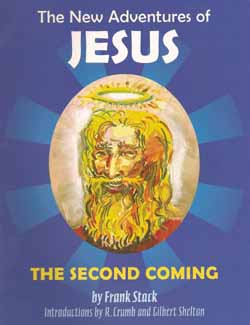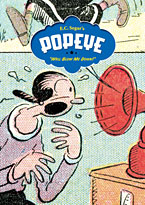
By Elzie Crisler Segar (Fantagraphics Books)
ISBN: 978-1-56097-874-9
Elzie Crisler Segar was born in Chester, Illinois on 8th December 1894.His father was a handyman, and Elzie’s early life was filled with the kinds of solid blue-collar jobs that typified his generation of cartoonists. He worked as a decorator and house-painter, and played drums, accompanying vaudeville acts at the local theatre. When the town got a movie house he played for the silent films, absorbing the staging, timing and narrative tricks from the close observation of the screen that would become his bread-and-butter as a cartoonist. He was working as the film projectionist, when aged 18, he decided to become a cartoonist and tell his own stories.
Like so many others he studied art via mail, in this case W.L. Evans’ cartooning correspondence course out of Cleveland, Ohio (from where Jerry Siegel and Joe Shuster would launch Superman upon the world), before gravitating to Chicago where he was “discovered†by Richard F. Outcault – arguably the inventor of newspaper comic strips with The Yellow Kid and Buster Brown – who got him an introduction at the prestigious Chicago Herald. Still wet behind the ears, Segar’s first strip, Charley Chaplin’s Comedy Capers, debuted on 12th March 1916.
In 1918 he married Myrtle Johnson and moved to William Randolph Hearst’s Chicago Evening American to create Looping the Loop, but the Managing Editor William Curley saw a big future for Segar and packed the newlyweds off to New York and the King Features Syndicate.
Within a year Segar was producing Thimble Theatre, which launched December 19th 1919 in the New York Journal. It was a pastiche of Movie features similar to Hairbreadth Harry and Midget Movies with a repertory cast who would act out comedies, melodramas, comedies, crime-stories, chases and especially comedies, for huge daily audiences. The core cast included parental pillars Nana and Cole Oyl, their lanky daughter Olive, diminutive-but-pushy son Castor and Olive’s plain and simple, sometime boyfriend Horace Hamgravy (later just Ham Gravy).
In 1924 he created a second daily strip The 5:15; a surreal domestic comedy featuring weedy commuter and would-be inventor John Sappo and his formidable wife Myrtle (obviously quite a common name, hmm?). A born storyteller, Segar had from the start an advantage even his beloved cinema couldn’t match. His brilliant ear for dialogue and accent shone out from his admittedly average adventure plots, adding lustre to stories and gags he always felt he hadn’t drawn well enough. After a decade or so and just as cinema caught up with the invention of “talkies†he finally discovered a character whose unique sound and individual vocalisations blended with a fantastic, enthralling nature to create a literal superstar.
Popeye the sailor, brusque, incoherent, plug-ugly and stingingly sarcastic, shambled on stage midway through the adventure ‘Dice Island’, (on January 17th 1929: see E.C. Segar’s Popeye volume 1: “I Yam What I Yam!â€) and once his part was played out, simply refused to leave. Within a year he was a regular, and as the strip’s circulation skyrocketed, he became the star. Eventually the strip was changed to Popeye and all of the old gang except Olive were consigned to oblivion…
Popeye inspired Segar. The near decade of funny thrillers that followed revolutionised the industry, laid the groundwork for the entire superhero genre (but sadly, usually without the leavening underpinnings of his self-aware humour) and captivated the whole wide world. The truly unique cast of characters invented in this period: Sea Hag, Toar, Poopdeck Pappy, Swee’pea, Eugene the Jeep, Alice the Goon, George W. Geezil, and especially J. Wellington Wimpy (potentially as big and innovative a star as Popeye) – even Professor O.G. Wotasnozzle in the Sappo daily strip which had evolved into the Sunday Popeye “Topper†– all individually verge on manic brilliance, and combined to make Popeye a global figure to rival Mickey Mouse, Tarzan and Sherlock Holmes. To most of the world Popeye was real.
All the attendant peripherals of a major brand accrued to Popeye. There were toys, games premiums, books, comics, film, radio shows, and especially those incredible animated cartoons. Tragically Segar died at the height of his creative powers and with so much more magic still to make on 13th October 1938, sole creator of an incredible galaxy of imagination, but his legacy briefly lived on through his assistant Forrest “Bud†Sagendorf, before the syndicate appointed Doc Winner, Tom Sims, Ralph Stein and Bela Zambuly to work on the printed strip, whilst the animated features increasingly became the main means of bringing Popeye to the world – but it just wasn’t the same.
Sagendorf returned in1958 and his loose, rangy style and breezy scripts brought the strip itself back to the forefront of popularity and made reading it cool once more. He wrote and drew Popeye until Bobby London took over in 1994.
These superb hardback collections are the perfect means of discovering or rediscovering Segar’s magical tales. The second huge volume (almost 14 ½ by 10½ inches) contains a fascinating essay from historian Donald Phelps, a testimonial from Mort “Beetle Bailey†Walker which includes the beautiful inspirational drawing Segar sent the young fan in 1934, and another batch of incredible tales from the daily and Sunday strips.
The black and white section here (covering December 22nd 1930 to June 6th 1932) sees Popeye, Castor and Olive soar to stardom in the fabulous western spoof ‘Clint Gore, the Outlaw’ and strike a blow for the Depression-era poor by inventing a financial institution that gives money away in ‘A One-Way Bank’, before resuming their globe-trotting adventuring in ‘The Great Rough-House War’ and its immediate sequel ‘Tragedy in the Land of Saps’ wherein the peculiar King Blozo of Nazilia seeks aid in ending a war with the neighbouring kingdom of Tonsylania – although the real problem seems to be his own over-ambitious Generals and the fact that all his soldiers are cowards…
This classy screwball epic displays Segar’s trenchant skill with the sharp swift scalpel of satire as well as broad slapstick, and has glorious overtones of if not actual influences upon the Marx Brothers gem “Duck Soup.†With an initially reluctant Popeye compelled by his sense of duty to become King of the unlovable Nazilians, it’s also where the superman sailor reveals for the first time the strength inducing properties of Spinach…
From there Popeye and Olive head back to the wild, wild west to visit ‘Skullyville, Toughest Town in the World’ and we’re treated (I think that’s the word) to the unforgettable yet frankly grisly vision of Olive Oyl as a bar hall dancer in a raucous, ridiculous romp that’s jam-packed with lampooned cowboy clichés and hilariously brilliant original gags.
The full-colour Sunday pages cover March 1st 1931 to October 2nd 1932, with the increasingly absurdist Sappo toppers thoroughly complimenting the whacky shenanigans of the lead feature. May 8th is particularly noteworthy for the first appearance of insane Professor O.G. Wotasnozzle – another Segar walk-on who would usurp his host feature…
The Popeye strip continued the uproarious and exceedingly violent boxing career of the one-eyed sea-dog, who took on all exceedingly monstrous comers, including the awesome man-mountain Tinearo, Kid Klutch (a giant gorilla) and even a robot boxer as the increasingly obsessive and belligerent Mr. Kilph, crazed by his inability to beat the grizzled sailor-man, slipped slowly into utter wackadoodleness.
When not beating the stuffing out of his opponents Popeye pursued his flighty, vacillating and irresolute Olive Oyl with desperate verve, if little success, and his life was forever changed when the ever-so-corruptible and adorably contemptible J. Wellington Wimpy made his debut.
The engaging Mr. Micawber-like coward, moocher and conman was first seen on 3rd May 1931 as an unnamed referee in the bombastic month-long bout against Tinearo but he obviously struck a chord with Segar who gradually made him a (usually unwelcome) fixture. Always hungry, ever happy and eager to take a bribe, we learned his name in the May 24th installment and he uttered the first of his many immortal catchphrases a month later. It was June 21st – but “I would gladly pay you Tuesday for a hamburger todayâ€, like most phrases everybody knows, actually started as ‘Cook me up a hamburger, I’ll pay you Thursday’
There will be more of Wimpy’s incredible influence in volume 3, but for now another aspect of Popeye’s complex character was revealed in an extended sequence that ran from May 29th 1932-July 17th, one that quickly secured his place in reader’s hearts.
The sailor was a rough-hewn orphan, who loved to gamble and fight, not too smart and superhumanly powerful, but he was a big-hearted man with an innate sense of decency who hated injustice – even if he couldn’t pronounce it. When Mary Ann, a starving little girl, tried to sell him a flower, he adopted her, taking her from the brutal couple who used her in a begging racket. He grew to love her and there’s a genuine sense of happy tragedy when he finds her real parents and gives her up. That such a rambunctious, action-packed comedy adventure serial could so easily turn an audience into sobbing sentimental pantywaists is a measure of just how great a spellbinder Segar was…
These tales are as vibrant now as they’ve ever been and comprise a world classic of graphic literature that only a handful of creator’s have ever matched. No one has ever bettered Segar’s Popeye and these superb volumes are books you’ll treasure for the rest of your life. Don’t miss them.
© 2006 Fantagraphics Books Inc. All comics and drawings © 2006 King Features Inc. All rights reserved.

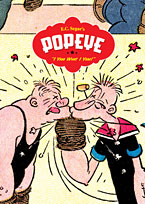

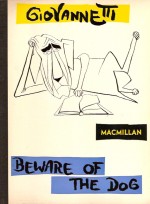
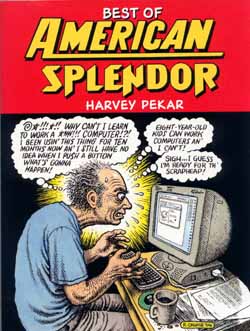 Â
 